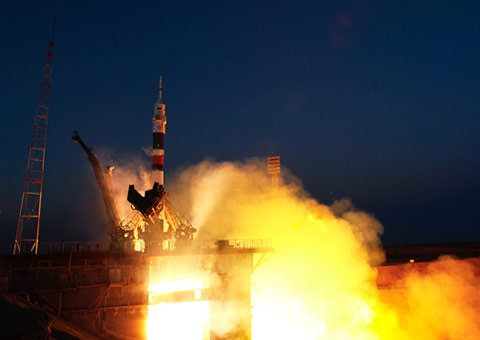A Russian spacecraft that is tumbling around the Earth after it malfunctioned en route to the International Space Station (ISS) could remain in orbit for more than a week before crashing down to Earth.
Thomas Reiter, director of human spaceflight and operations at the European Space Agency, said that if Russian engineers could not regain control of the stricken vessel it could spiral down to Earth within the next 10 days.
The 7-metre-long Progress 59 vessel malfunctioned soon after reaching orbit on Tuesday and went into an uncontrolled spin. Flight controllers have failed to establish two-way communications with the spacecraft as it passes over Russian ground stations.
An official Russian space agency statement is expected later on Wednesday. An official familiar with the situation told Agence France-Presse: “It has started descending. It has nowhere else to go. It is clear that absolutely uncontrollable reactions have begun.”
Igor Komarov, head of Roscosmos, the Russian space agency, was quoted by agency LifeNews as saying: “A safe docking with the ISS is not possible. We are working out different options for a water landing.”
The Progress capsule is used to carry food, water, fuel and other supplies to the space station. Once it has been unloaded, it is designed to be jettisoned in a controlled re-entry over the southern Pacific that ensures any fragments that do not burn up in the atmosphere land in the ocean.
The concern is now that if the spacecraft falls back to Earth on an uncontrolled path some fragments may fall on land. The danger to people is slim: more than two-thirds of the Earth’s surface is covered by water and only 3% of the land is heavily populated.
#Progress 59 docking called off. Russian flight controllers assessing options. More details as available Latest: http://t.co/th9dmHiv2P
— Intl. Space Station (@Space_Station) April 29, 2015
“Re-entry is normally done over the south Pacific to avoid any debris falling on firm terrain,” said Reiter, a former astronaut. “Not everything will burn up and if it’s an uncontrolled entry then there could be fragments that will hit the surface.
“If my colleagues can’t get it under control, that could be within a week, maybe one and a half weeks at most.”
The Russian flight controllers have a chance to make contact with the capsule every 90 minutes when it soars overhead.
Reiter said he had instructed the space agency’s European space operations centre in Darmstadt to track the spacecraft so that teams can predict when and where the spacecraft will come down if it cannot be rescued.
Such calculations are not easy, because it is impossible to predict exactly how a tumbling spacecraft will break up as it re-enters. “It depends on the motion of the vehicle, and the fuel tanks might or might not explode and lead to a further fragmentation,” Reiter said.
The European Space Agency last year retired its own cargo vessel, the ATV, which at 20 tonnes is far heavier than the Russian Progress spacecraft. The space agency has never recorded any debris from the ATV surviving re-entry, but believes that its bulky docking mechanism could theoretically remain intact.
The spacecraft launched from the Baikonur cosmodrome in Kazakhstan at 8.09am UK time on Tuesday and was intended to dock with the space station on Thursday. That rendezvous plan has now been postponed indefinitely. On board are 2.5 tonnes of food, water, fuel and other supplies for the ISS crew.
The six crew on board the International Space Station have enough supplies to cope if the spacecraft cannot be saved.
The problem became apparent when the spacecraft failed to confirm that its antennas had deployed properly and that a propulsion unit needed for docking had pressurised. Engineers hope to get the spacecraft into a stable orbit until the glitch can be fixed.
The spacecraft is 160 miles high and travelling at more than 16,000 miles per hour. That altitude is sufficiently below the space station to pose the crew no problems, but some satellites might need to take evasive manoeuvres. Such moves were becoming ever more necessary in space, said Reiter.
The Russians still hope to re-establish communications with the spacecraft and place it in a safe orbit while they work to solve any glitches. If that work goes to plan, they may be able to regain control and re-attempt docking with the space station.










